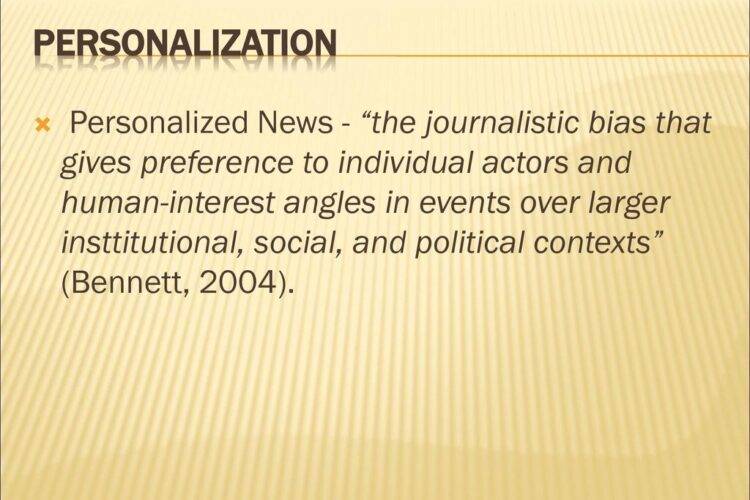
I. Introduction to personalization bias
II. Causes of personalization bias
III. Impact of personalization bias on decision-making
IV. Strategies to mitigate personalization bias
Introduction to Personalization Bias
Hey there! Let’s talk about personalization bias. Have you ever noticed how we tend to prefer information that confirms our existing beliefs and values? That’s personalization bias in action!
Personalization bias is a common cognitive bias that affects how we process information. It occurs when we filter information through our own personal beliefs, experiences, and preferences, leading us to favor information that aligns with what we already know or believe to be true.
Imagine you’re researching a topic online, and you come across two articles with conflicting views. You’re more likely to spend more time reading and engaging with the article that supports your existing beliefs, while dismissing or ignoring the one that challenges your views. This is a classic example of personalization bias at play.
Personalization bias can be subtle, but its impact on decision-making can be significant. It can lead us to overlook valuable insights, dismiss alternative perspectives, and ultimately make biased or flawed decisions based on incomplete information.
Causes of Personalization Bias
Have you ever made a decision based on your personal preferences rather than objective facts? If so, you may have experienced personalization bias. This cognitive bias occurs when individuals rely too heavily on their own experiences and beliefs, leading them to make decisions that may not be in their best interest.
So, what are some of the causes of personalization bias? Let’s delve into a few key factors:
- Familiarity Bias: People tend to favor things that are familiar to them. This bias can lead individuals to choose options they are comfortable with, even if there are better alternatives available.
- Confirmation Bias: This occurs when individuals seek out information that confirms their existing beliefs, while ignoring evidence that contradicts them. This can reinforce personalization bias by limiting exposure to diverse perspectives.
- Emotional Attachment: When individuals have a strong emotional attachment to a particular outcome, they may prioritize their feelings over rational analysis. This can cloud judgment and lead to biased decision-making.
- Stereotyping: Preconceived notions or stereotypes about certain groups can influence decision-making. By relying on stereotypes, individuals may overlook opportunities or discount the perspectives of others.
It’s important to recognize these causes of personalization bias in order to make more informed decisions. By understanding the factors that contribute to this bias, individuals can take steps to mitigate its impact and improve the quality of their decision-making process. Remember, being aware of your own biases is the first step towards overcoming them.
So, the next time you catch yourself making a decision based solely on your personal preferences, take a moment to reflect on the potential causes of personalization bias at play. By being mindful of these factors, you can make more objective and well-informed choices that align with your goals and values.
In the next section, we will explore the impact of personalization bias on decision-making and discuss strategies to mitigate its effects. Stay tuned for expert tips on how to overcome personalization bias and make better decisions in your personal and professional life.
Impact of Personalization Bias on Decision-Making
Have you ever found yourself making decisions based on personal preferences rather than objective factors? That’s a classic example of personalization bias at play. This bias occurs when we rely too heavily on our own experiences, beliefs, and preferences when making choices, often leading us to overlook important information that may contradict our views.
So, what’s the big deal with personalization bias and how does it affect our decision-making process? Let’s dig into it.
First and foremost, personalization bias can severely limit the range of options we consider when making decisions. By focusing solely on what we already know or like, we may miss out on potentially better alternatives that could lead to more successful outcomes. This narrow perspective can hinder our ability to make well-informed and rational decisions.
Moreover, personalization bias can cloud our judgment and prevent us from objectively assessing risks and benefits. When we let our personal preferences take the lead, we may fail to weigh the pros and cons of different options effectively. This can result in making decisions that are not in our best interest or that may lead to negative consequences in the long run.
Furthermore, personalization bias can also impact our relationships with others. When we prioritize our own preferences over those of others, we may overlook their needs, feelings, and perspectives. This can lead to misunderstandings, conflicts, and strained relationships, both personally and professionally.
Now, you might be wondering, how can we combat personalization bias and make more objective decisions? One effective strategy is to actively seek out diverse perspectives and consider alternative viewpoints before making a choice. By broadening our horizons and being open to different ideas, we can avoid falling into the trap of personalization bias.
Another helpful approach is to gather and analyze relevant data and information before making a decision. By relying on facts and evidence rather than personal biases, we can make more rational and informed choices that are based on objective criteria.
Additionally, it’s important to take a step back and reflect on our own biases and assumptions. By being aware of our personal preferences and how they may influence our decision-making process, we can take steps to mitigate the impact of personalization bias and make more balanced choices.
In conclusion, personalization bias can have a significant impact on our decision-making process, leading us to make choices that may not be in our best interest. By recognizing the signs of personalization bias and taking proactive steps to address it, we can make more objective, rational, and successful decisions in all aspects of our lives.
Strategies to Mitigate Personalization Bias
So, you’ve learned about personalization bias and how it can impact decision-making. But fear not, there are ways to combat this bias and make more objective choices. Here are some strategies to help you mitigate personalization bias:
1. Increase Awareness
The first step in overcoming personalization bias is to recognize when it’s happening. Pay attention to your decision-making process and be aware of any biases that may be influencing your choices. By acknowledging the existence of personalization bias, you can take proactive steps to prevent it from clouding your judgment.
2. Seek Diverse Perspectives
One way to counter personalization bias is to seek out diverse perspectives and opinions. Surround yourself with people who have different backgrounds, experiences, and viewpoints. By considering a range of perspectives, you can gain a more well-rounded understanding of a situation and make more informed decisions.
3. Use Data and Evidence
Another effective strategy for mitigating personalization bias is to rely on data and evidence to guide your decision-making. When faced with a choice, gather as much relevant information as possible and use data-driven analysis to inform your decision. By basing your choices on objective evidence, you can reduce the influence of personal biases.
4. Implement Decision-Making Processes
Developing structured decision-making processes can also help mitigate personalization bias. Create a framework for evaluating options, setting criteria for decision-making, and weighing the pros and cons of each choice. By following a systematic approach, you can reduce the impact of personal biases and make more rational decisions.
5. Take Time to Reflect
Lastly, it’s important to take the time to reflect on your decisions and consider whether personalization bias may have played a role. After making a choice, think about the factors that influenced your decision and whether any biases may have skewed your judgment. By reflecting on your choices, you can learn from past mistakes and improve your decision-making process in the future.
In conclusion, personalization bias can have a significant impact on decision-making, but by implementing these strategies, you can mitigate its effects and make more objective choices. Remember to increase awareness, seek diverse perspectives, use data and evidence, implement decision-making processes, and take time to reflect on your decisions. By taking these steps, you can overcome personalization bias and make more informed and rational decisions.










Comments